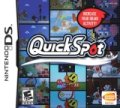 About GamePeople
About GamePeople
Subscribe to the Family Gamer column:![]() RSS or
RSS or
![]() Newsletter.
Newsletter.

Format:
DS
Genre:
Minigames
Buy/Support:
Support Andy, click to buy via us...
This questionably titled game updates a well worn premise that has graced a million kid's magazines. It achieves something of a coup by endowing this classic game with new life.
What is essentially spot-the-difference for the DS may sound like something of a dull proposition, but a little bit of Namco Bandai magic - not to mention a healthy dose of their intellectual property - and out pops a fully formed portable experience as complete as Tetris or Sudoku. It is therefore surprising that the game still awaits a European release. Thankfully we got our hands on a US import to review in the meantime.
The gameplay, as you would expect, revolves around spotting differences between two pictures; one on the top screen and one on the bottom. How hard can it be? The game designers have nowhere to hide, no gaming tricks or conventions can be pulled out of the bag here. It is simply a battle of the psyche. What it can do however is to use some of the oldest visual tricks in the book - think back to those optical illusions or Escher drawings and you are getting close. The game does its best to draw the player's eye away from the areas that differ, or implement such subtle differences that they become fiendishly hard to spot. It walks the narrow line between making the differences too subtle or too obvious.
Whereas a paper based spot the difference - in this week's Beano say - has to be a static image, the DS can of course make the pictures move. This introduces another level of complexity. Not only are you looking for differences in the base pictures but also in the way they are animated. In addition to other slight of hand, these movements are also employed to distract the eye from seeing other static visual differences that lie nearby. It is surprising how effective this is, and on occasion you would swear blind there are no more differences to spot.
The game turns into a delightfully extended level of WarioWare - one that has been lovingly honed to the point of perfection whilst leaving the rough kernel of the idea at the centre of it all.
For those of you that remember back to Namco's hey day there is another clever distraction technique on hand. The game is littered with references and memorabilia from their older titles; a character here, a logo there, or even a particular colour palette all remind the informed gamer of a bygone age of games and the developer's prestigious history. If you are not careful, the excitement and memories of these images also act to distract your eye from the task in hand. It is surprising how familiarity with a picture makes it much harder to notice the differing details. And for Quick Spot the devil is certainly in the detail - because that's where the differences are.
In addition to the normal spot the difference mode where you have a certain number of chances to spot all the differences on a page, Quick Spot provides some time limited action as well. This sets a timer and challenges you to find as many differences as you can before it runs out. The simple pressure of a time limit does strange things to the human brain, as panic sets in and it find that even the most obvious of differences go unnoticed.
The game is all wrapped up with some auditory material from Namco Bandai's back catalogue. A variety of chip tunes and disco rhythms give the game a J-Pop feel that suites it down to the ground. The original Japanese voice work (for there is no hiding the fact that this is a localisation) has been replaced with some similarly high pitched school girl tones - think Chung Lea on helium.
All this might very well add up to a messy collection of ideas for a lesser developer. But with Namco Bandai at the helm the game turns into a delightfully extended level of WarioWare - one that has been lovingly honed to the point of perfection whilst leaving the rough kernel of the idea at the centre of it all. Such is the mastery of the delivery that this package is incredibly compelling. It really shouldn't (as we have said) this has all been seen before many times. But the fit of the game mechanic to the DS's two screens, the animation and art style of the Namco back catalogue and the joy with which they go about their task make this something special. Add to this the fact that it is a game that my four year old daughter enjoys just as much as me, and you have the sense that the DS could handle many more games like this.



Andy Robertson writes the Family Gamer column.
"Videogame reviews for the whole family, not just the kids. I dig out videogame experiences to intrigue and interest grownups and children. This is post-hardcore gaming where accessibility, emotion and storytelling are as important as realism, explosions and bravado."
Here are the games I've been playing recently:
© GamePeople 2006-13 | Contact | Huh?

|
Family Video Game Age Ratings | Home | About | Radio shows | Columnists | Competitions | Contact
With so many different perspectives it can be hard to know where to start - a little like walking into a crowded pub. Sorry about that. But so far we've not found a way to streamline our review output - there's basically too much of it. So, rather than dilute things for newcomers we have decided to live with the hubbub while helping new readers find the columnists they will enjoy. |
Our columnists each focus on a particular perspective and fall into one of the following types of gamers:
|